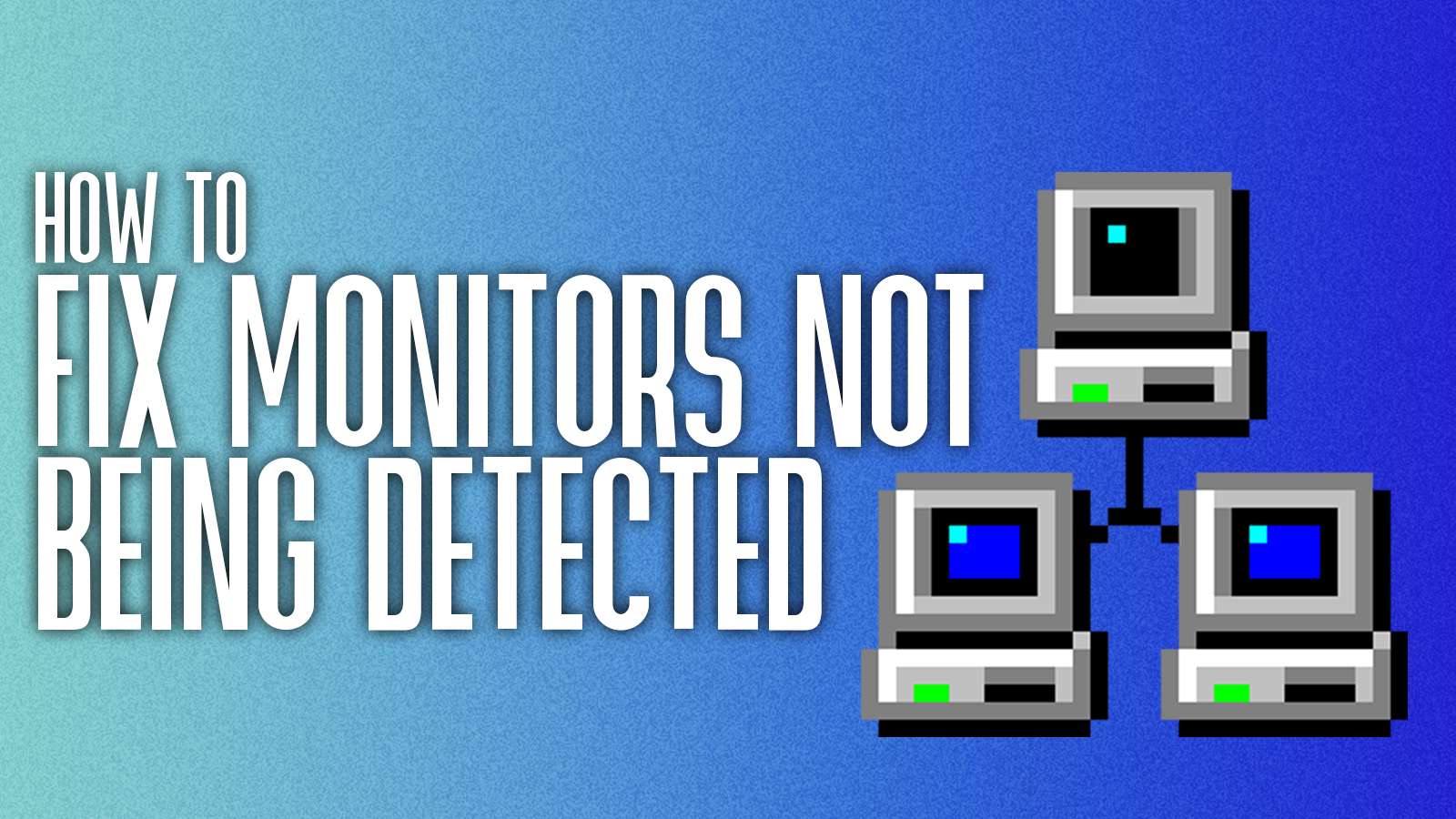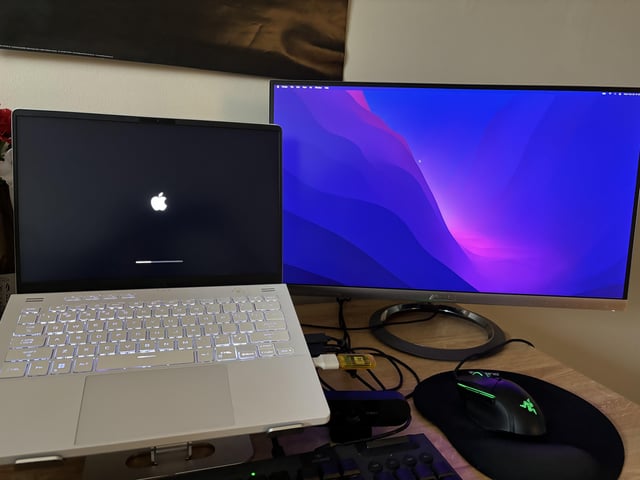Main Monitor Not Detected usually results from a loose cable or incorrect display settings. Check connections and system settings first.
Experiencing issues with your main monitor can be frustrating, especially when it suddenly stops getting detected. This problem is often due to simple issues such as a loose cable or incorrect display settings. Ensuring that all cables are securely connected and checking your computer’s display settings can quickly resolve the issue.
Sometimes, updating your graphics drivers or restarting your computer might also help. Always verify these basic troubleshooting steps before considering more complex solutions. This guide aims to help you identify and fix the problem efficiently, saving you time and effort. Follow these steps to get your main monitor back in working order.

Credit: www.reddit.com
Common Causes
Experiencing issues with your main monitor not being detected can be frustrating. Understanding the common causes can help you troubleshoot and resolve the problem efficiently. Below are some of the most frequent reasons your main monitor might not be detected.
Loose Connections
One of the simplest reasons for your monitor not being detected is loose connections. Ensure that all cables are firmly connected to both the monitor and the computer.
- Check the power cable connection.
- Ensure the video cable is securely plugged in.
- Verify the connection at the monitor and the computer ends.
Faulty Cables
Sometimes, the issue might be due to faulty cables. A damaged cable can prevent the signal from reaching your monitor.
Here are steps to check for faulty cables:
- Inspect the cable for visible damage or wear.
- Try using a different video cable.
- If possible, test the cable with another monitor.
Consider replacing cables that show signs of damage or wear. Using high-quality cables can also improve signal reliability.

Credit: www.reddit.com
Hardware Checks
Experiencing issues with your main monitor not being detected can be frustrating. Before diving into complex solutions, conduct basic hardware checks. These checks can often resolve the issue quickly and efficiently.
Inspect Ports
First, inspect the ports on both your monitor and computer. Ensure all connections are secure. Loose cables can cause detection issues. Check for any visible damage to the ports. Damaged ports may need professional repair.
Use a flashlight to look inside the ports. Dust or debris can block the connection. Clean the ports with compressed air if necessary. Also, ensure you are using the correct port for your setup. Some computers have multiple display outputs.
Test With Another Monitor
Testing with another monitor can help identify the problem. Connect a different monitor to your computer. If the second monitor works, your original monitor might be faulty. Conversely, if the second monitor also fails, the issue might be your computer.
This step helps isolate whether the problem is with the monitor or the computer. Make sure to use the same cables when testing with another monitor. This ensures the cables are not the issue.
| Check | Description |
|---|---|
| Ports | Ensure all connections are secure and undamaged. |
| Clean Ports | Remove dust or debris with compressed air. |
| Test Monitor | Use a second monitor to isolate the issue. |
- Secure connections to avoid loose cable issues.
- Check for visible damage in ports.
- Use a flashlight to inspect ports closely.
- Clean ports with compressed air.
- Test with another monitor to identify faults.
Software Issues
Sometimes, your main monitor might not be detected due to software issues. These problems can often be resolved by addressing driver problems or operating system glitches.
Driver Problems
Drivers act as a bridge between your computer and its hardware. If they become outdated or corrupted, your main monitor may not be detected. Follow these steps to resolve driver issues:
- Update Drivers: Use Device Manager to check for updates. Right-click on your display adapter and select Update driver.
- Reinstall Drivers: Uninstall the current driver and then restart your computer. Windows should automatically reinstall the correct driver.
- Download from Manufacturer: Visit the GPU manufacturer’s website. Download and install the latest driver version.
Operating System Glitches
Sometimes, your operating system may have glitches causing the monitor detection issue. Here are some steps to address this:
- Restart Your Computer: A simple restart can fix many software issues.
- Check for Updates: Go to Settings > Update & Security and click Check for updates. Install any available updates.
- Use Safe Mode: Boot your computer in Safe Mode to troubleshoot. Safe Mode loads only essential drivers and services.
- Run System File Checker: Open Command Prompt as an administrator. Type
sfc /scannowand press Enter. This will check for and repair corrupted system files.
Graphics Card
Having trouble with your main monitor not being detected? The graphics card is often the culprit. This critical component ensures your display works correctly. Let’s explore some solutions to fix it.
Update Drivers
Outdated drivers can cause your monitor to not be detected. Follow these steps:
- Open Device Manager on your computer.
- Find Display Adapters.
- Right-click on your graphics card.
- Select Update Driver.
- Choose Search automatically for updated driver software.
Updating drivers can fix detection issues. Always keep drivers up to date.
Reseat The Card
Sometimes, the graphics card might be loose. Follow these steps to reseat it:
- Turn off your computer.
- Unplug all cables and open the case.
- Locate the graphics card.
- Carefully remove the card from its slot.
- Clean any dust from the slot and card.
- Reinsert the graphics card firmly.
- Close the case and reconnect all cables.
- Turn on your computer and check the monitor.
Reseating the card can improve the connection and resolve the issue.
Bios Settings
Experiencing a ‘Main Monitor Not Detected’ issue can be frustrating. One primary area to check is the BIOS settings. The BIOS (Basic Input/Output System) controls your computer’s hardware. Adjusting BIOS settings can sometimes resolve display issues.
Check Display Settings
First, ensure your display settings in BIOS are correct. Restart your computer and press the DEL or F2 key to enter the BIOS setup.
- Navigate to the Advanced tab.
- Locate the Integrated Graphics Configuration or similar option.
- Ensure the primary display is set to PCI-E if using a dedicated GPU.
Reset Bios
If changes to the display settings don’t help, resetting the BIOS might be necessary. This action will restore default settings, which can fix detection issues.
- Enter BIOS setup by pressing DEL or F2 during startup.
- Find the Save & Exit tab.
- Select Restore Defaults or Load Optimized Defaults.
- Save changes and exit BIOS.
After resetting, restart your computer and check if the monitor is detected.

Credit: www.dexerto.com
Power Supply
Your monitor might not be detected because of power supply issues. Ensuring the monitor gets enough power is crucial. Let’s explore how to troubleshoot this.
Check Power Connections
Start by checking all power connections. Ensure the power cable is firmly connected to the monitor. It should also be securely plugged into the power outlet.
- Verify that the power cable is not damaged.
- Try using a different power outlet.
- Ensure the power strip (if used) is turned on.
Inspect Power Supply Unit
If your monitor still isn’t detected, inspect the power supply unit. This part can sometimes fail, causing power issues.
| Step | Action |
|---|---|
| 1 | Turn off and unplug the monitor. |
| 2 | Inspect the power supply unit for any visible damage. |
| 3 | Smell for any burnt odor, which indicates a problem. |
| 4 | If possible, test the monitor with a different power supply. |
If the power supply unit seems faulty, consider replacing it. Ensuring a stable power supply is key for your monitor’s performance.
Monitor Settings
Experiencing issues with your monitor not being detected? Often, the solution lies within the monitor settings. Adjusting these settings can help your computer recognize the monitor correctly. Here, we’ll explore two critical settings: input source and factory reset.
Adjust Input Source
Sometimes, the main issue is with the input source. Monitors have multiple input sources, such as HDMI, VGA, and DisplayPort. Your monitor may be set to a different input source.
- Press the menu button on your monitor.
- Navigate to the input source settings.
- Select the correct input source (HDMI, VGA, etc.).
- Confirm your selection and exit the menu.
If the input source matches the cable type, your monitor should be detected.
Factory Reset
Another effective solution is performing a factory reset. This action restores the monitor to its default settings. Follow these steps:
- Open the monitor’s menu using the menu button.
- Go to the settings or setup section.
- Find the factory reset option.
- Select it and confirm the reset.
This can fix settings issues that might be causing detection problems.
| Setting | Steps to Adjust |
|---|---|
| Input Source |
|
| Factory Reset |
|
By adjusting the input source or performing a factory reset, you can often resolve the issue of your main monitor not being detected. These steps are simple and can save you a lot of hassle.
Multiple Displays
Experiencing issues with your main monitor not detected can be frustrating. Setting up multiple displays can enhance your productivity. Here, we’ll explore how to manage different display settings.
Extend Display
Using the Extend Display option allows you to spread your desktop across multiple screens. This setup helps you multitask efficiently. You can drag windows from one screen to another.
- Right-click on the desktop
- Select Display Settings
- Choose Extend These Displays
- Click Apply to save changes
This setup is ideal for professionals and gamers. It offers a wider workspace and a more immersive experience.
Duplicate Display
The Duplicate Display option mirrors your primary screen on another monitor. This setup is useful for presentations and meetings.
- Right-click on the desktop
- Select Display Settings
- Choose Duplicate These Displays
- Click Apply to confirm
This setup ensures everyone sees the same content. It’s perfect for collaborative work and teaching.
If your main monitor is not detected, these steps can help. Make sure cables are connected properly. Update your graphics drivers if needed. Enjoy the benefits of multiple displays!
Connection Types
When your main monitor is not detected, the connection type might be the issue. Different connection types have their quirks and problems. The most common types are HDMI and DisplayPort.
Hdmi Issues
HDMI is widely used for connecting monitors. It can transmit both audio and video. But sometimes, issues arise.
- Loose Connections: Ensure the HDMI cable is securely plugged in.
- Damaged Cable: Check for any visible damage to the cable.
- Port Problems: Try a different HDMI port on your monitor or computer.
Using a high-quality HDMI cable can help avoid many problems. Make sure the cable supports the required resolution.
Displayport Troubles
DisplayPort is another popular option for monitor connections. It supports high resolutions and refresh rates. But it can also have issues.
- Incorrect Settings: Check the monitor and computer settings.
- Firmware Updates: Ensure your devices have the latest firmware.
- Adapter Issues: If using an adapter, verify it is working properly.
DisplayPort cables can sometimes be tricky. Always use certified DisplayPort cables for better reliability.
| Connection Type | Common Issues |
|---|---|
| HDMI |
|
| DisplayPort |
|
Check your cables and ports regularly. This can save you a lot of hassle.
Professional Help
Sometimes, troubleshooting your monitor issues on your own can be overwhelming. Seeking professional help ensures that your monitor gets fixed properly. This section will guide you on when to seek help and how to choose the right technician.
When To Seek Help
Knowing when to call a professional is crucial. Here are some scenarios:
- No display even after checking all connections.
- Frequent flickering that disrupts your work.
- Unusual noises coming from the monitor.
- Distorted or fuzzy images appearing on the screen.
These issues often require expert intervention. Do not attempt to fix complex problems yourself. It might cause more damage.
Choosing A Technician
Selecting the right technician is important. Follow these tips:
- Check credentials: Ensure the technician is certified.
- Read reviews: Look for positive customer feedback.
- Compare prices: Get quotes from multiple technicians.
- Ask questions: Inquire about their experience and methods.
Make sure the technician offers a warranty on their work. This guarantees quality service and peace of mind.
Frequently Asked Questions
Why Is My Monitor Not Detected?
Your monitor might not be detected due to loose cables, outdated drivers, or incorrect display settings. Ensure connections are secure and drivers updated.
Why Is My First Monitor Not Displaying?
Check the monitor’s power connection and ensure it’s turned on. Verify the cable connection to the computer. Select the correct input source on the monitor. Ensure the graphics card is properly seated. Update or reinstall your graphics driver.
Why Isn’t My First Monitor Being Detected?
Your first monitor might not be detected due to loose cables, outdated drivers, or incorrect settings. Ensure connections are secure. Update graphics drivers and check display settings.
Conclusion
A non-detecting main monitor can disrupt productivity. Follow our troubleshooting steps to resolve the issue quickly. Regularly check cables and drivers to avoid problems. By maintaining your setup, you’ll ensure smooth operation. Enjoy a seamless computing experience with these simple solutions.
Stay proactive to keep your monitor running efficiently.

Hello Good People! This is Pavel and Welcome to PC Delight!
I’m an Electronics Engineer by profession with a passion for Gaming & PC builds. When I came up with the idea for PC Delight, it was my goal to share & offer the very best PC building ideas to tech-loving people like myself.
Since my school days, I’ve been just addicted to gaming & PCs. That leads me to experiment with various ways around the very niche, resulting in great productivity. And I’m here to share those practical experiences. So that next time you start some experiment with your PC builds or struggle to cope with a certain game, I’m here with the solutions. With these philosophies, I started my journey in 2017 and just kept going.
